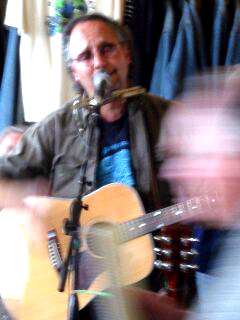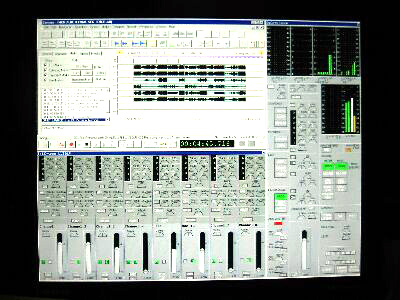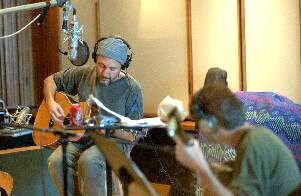|
You are reading the older HTML site
Positive Feedback ISSUE
15
Why
Surround Me With All This Sound?
David Elias is a professional musician and songwriter, as well as an honored member of the PFO community. Photographs courtesy of David Elias and company; image processing by David W. Robinson. In the beginning there was mono. I grew up listening to records at an early age, before I went to any school or any pre-school. All those years of first impressions were heard through a single speaker located from a built-in panel somewhere at the top of the wall in the living room. If I changed rooms, there was likely to be another single speaker somewhere in that room. I heard a lot of different styles of music from Mono Hi-Fi records for many years. Somehow I never associated the music I was hearing with a single woofer/tweeter pair somewhere up near the ceiling. And though it wasn't even a full mono playback through two speakers, the music was able to transcend location. It was to me, groups of people of great skill and knowledge playing incredible arrangements of something very easy to understand. They were clearly "in the room" and not "in the wall," so to speak. Less than 10 years later I bought my own first stereo hi-fi system through a mail order catalog. It had two speakers! I was still focused on the image of people playing music more than the image of the music itself. But after spending hundreds of dollars on the stereo system (Harmon Kardon receiver + EV speakers) I had begun to have a much deeper appreciation for how equipment might change the sound. Now after a few decades of pursuing music in various ways including lots of listening, performance, self-producing, recording, mixing and mastering of my own work, I am here considering the question "Why surround me with all this sound?" specifically as it relates to the 5.1 multichannel (surround sound) paradigm for audio playback such as DVD-A and SACD. If I didn't need it then to enjoy the experience, why do I need it now? The truth is, I probably don't need it now! But I prefer it now for quite a few reasons, as both a listener and as a recording musician.
Giving Yourself Space To begin with, there has always been an easily discernable difference between excellent (or at least very good) recordings and all the rest. This has been true for me no matter what kind of system was playing them. By "recording," I mean both the performance and the process of capturing the performance and playing it back. Certain records and fewer CD's had that really good feel to them. For me, this is the ability to record the performance, regardless of live, studio, overdub, etc., in an accurate way. In this case, "accurate" is a subjective term. It has to be accurate to the musicians and the producer in order to deliver the mood and impressions of the songs in the closest ways possible to their intentions, whatever those are. This challenge always includes the parameters of trying to recreate a space of some kind. The space might be the room the recording was made in, or a natural setting, or any other imaginable area or setting. It's always three-dimensional though, isn't it? Stereo can produce a 3-D image that locates, say, a singer in the center of the "stage" and arranges other instruments on either side of the singer. It achieves depth far beyond that. But surround sound gives the artist the benefits of setting up and controlling that space to a much greater degree. With the additional center channel and two rear channel speakers, the dynamics of the space can be much more accurately represented as part of the recording process itself. Instead of having to rely completely on the listening room itself for the boundaries of the space, surround sound lets you be much more precise in what that room sounds like. This is true from both a recording and a listening perspective. For Example On two occasions I've had the experience of trying to capture the nuances of a live acoustic band performing in the studio using a Direct Stream Digital (DSD) recorder. The first DSD experiment was done in November 2002 and resulted in the hybrid multichannel SACD called The Window. The same approach was used a second time this past summer 2004 and is now being mixed for both stereo and surround for a follow-up SACD.
The Sonoma workstation in action! We approached the problems in both cases with the idea of surround sound playback especially in mind. We were also limited to 8 tracks in both cases which made our live recording a nice challenge on the front-end. We used Meitner Labs converters (ADC8) to feed the DSD recorder (Sonoma). Of the 8 tracks available at least 2 were always used for the stereo image of the room. When possible, we used a third mic in the rear of the room for capturing ambient percussion sounds. Here is the breakdown of our live studio mic-ing for our most recent project:
The stereo image of the room is used as the basis for the final mix of the recording. Instruments and vocal tracks that were recorded as isolated channels are then added to and panned in the room mix to help accentuate positioning. Very little EQ is used, and reverb effects are used sparingly, if at all. Remember that the original stereo image of the room is combined with the live drum mix during recording, so it is critical that this is done carefully since it can't be changed after the session. Charlie Natzke at Slipperworld Studios saw to this and all the DSD recording on our latest project.
Slipperworld Studios When recording The Window we had a number of other instruments also in this mix, including combinations of accordion, electric guitar, keyboards, as well as my acoustic guitar. It makes it darned difficult if not impossible to overdub anything as an edit later, since everybody is in the live mix in the room. The rear channels may use the same stereo image to reflect the room's "back wall." (Note: The Window recordings used 2 more of the precious 8 DSD channels for capturing the rear surround channels.) The timing and bleed between the different mic's is also preserved and used in the final mix to help recreate the proper space dimensions. The result is a very natural sounding reproduction of the performance in the studio. It is spacious but intimate. It is live, but studio! The articulate nature of the stringed instruments is represented accurately in 3-D, even to the extent of a dobro guitar string's decay from the back of the room in the mandolin's or singer's mic's at the center and front of the room. I think you need surround sound to really pull this one off. On Central Issues and Deep Subjects Mixing audio for surround sound still has many different solutions and approaches. I don't claim to have any special insight into any of this. I have my own experience to share, for whatever that might be worth. Perhaps there is no single "best way" to approach some of these issues. I find it exciting that this is still open territory, and am always interested in listening to how some of the experts address it. One of the open questions is what to do with that darned center channel. Some will ignore it mostly if not altogether, while others choose to use it. We used the center channel in my projects to help place the vocal in front of other front stereo instruments. Another question to answer when creating a surround recording is what to do with that .1 sub-channel. My impression is that sub-channel mixing is a by-product of the film industry for those very, very low sounds, rumbles and effects. There are a lot of gotcha's here. The different combinations of sub-channel routing and crossover settings in listener setups makes this a whole field of possible landmines. Bass management in an SACD player or a preamp/processor seems to be something to turn off and avoid overall, which is ironic but true. So avoiding the use of the LFE/sub-channel (.1) in the surround sound mix for multichannel SACD seems the best way to let the bass flow naturally and avoid problems caused by different listener systems being setup different ways.
For The Music... I have probably omitted a few details, but I hope I provided a good basis for the ideas behind how we prepared for and ran our surround recordings. This is just one example of how surround sound can affect the way recordings are actually planned for studios or live performances. I find this just amazing! The results can be startling. I don't have anything against 2-channel stereo. I love stereo. Multichannel SACD gives you both surround sound and stereo mixes. Heck, I was happy listening to single speaker mono sounds before I knew about anything else. But I do feel that the use of DSD or other hi-rez recording and 5.1 multichannel mix/playback has advanced the art to a new and significantly different level. The fact that home theater is here in a big way makes this more relevant. The sales guys at The Good Guys tell me they sell video theater systems a million to one over audio systems. The fact that these systems usually go out with a Denon or some other universal player is music to my ears! Which leads to the one last thing I need to point out, even if it's already obvious to some: The benefits of hybrid SACDs and hybrid multichannel SACDs are going to be with consumers for many years to come. I can't think of any other similar huge advantage given to the consumer for their improved use and enjoyment any other time in history—-all with no additional purchase required. In fact the reverse is almost always true. In order to benefit from a higher or wider resolution in any product (computer speed, RAM density, digital camera, cell phone, wireless phone or LAN, TV/monitor….) you always have had to buy a new widget or more often a whole new replacement.
Not so
with hybrid SACDs. The buyer initially gets the immediate benefit of DSD
resolution on any standard player or even from ripped MP3's (this has been
pointed out to me many times by non-technical listeners). When that listener
eventually upgrades their stereo to a surround sound home theater system with a
universal player, that same SACD disc will suddenly deliver a 5.1 surround mix
they never heard before, no matter how many years ago they bought the disc.
Playing the SACD layer for the first time will cause their sound to improve, not
degrade. Amazing!
PFO readers who are interested in hearing David Elias' first SACD, The Window, will find that it can be previewed and purchased online at http://cdbaby.com/elias5. It is also available at your other regular online SACD sources: Acoustic Sounds or The Elusive Disc. Editors Note: "The Window" SACD was a final nominee in the 2003 Surround Music Awards category for emerging artists, held in Beverly Hills, Calif.
|








